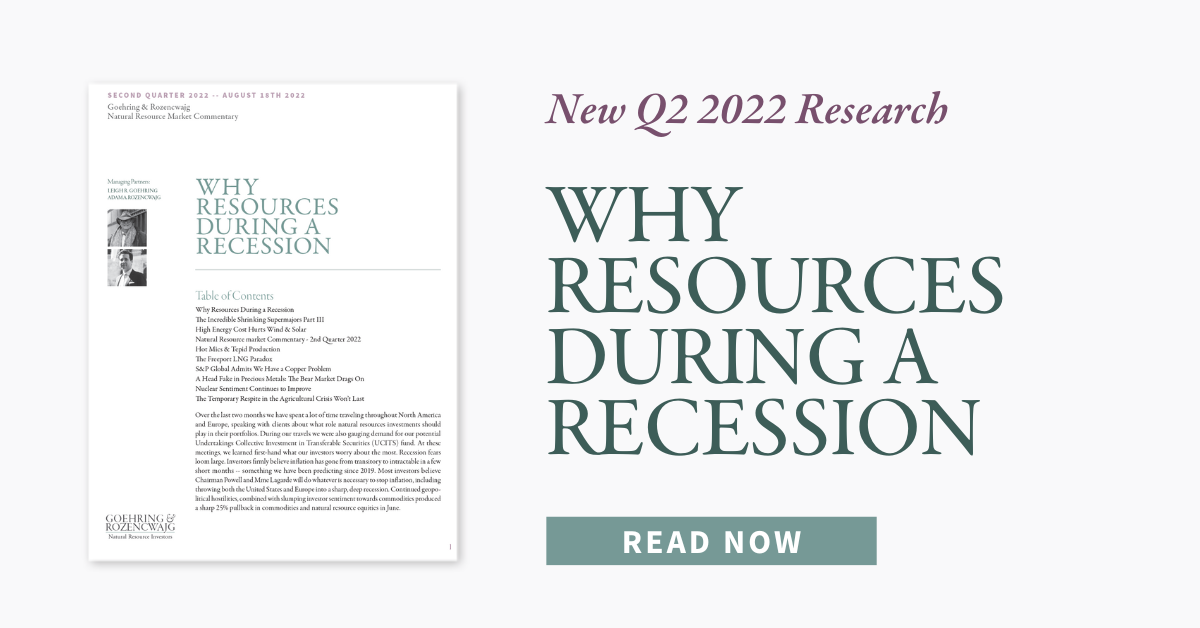The article below is an excerpt from our Q2 2022 commentary.
Our Q4 2021 commentary was entitled “The Distortions of Cheap Energy.” In our lead essay, we explained how extremely low energy prices throughout the 2010s distorted the cost of several energy transition technologies, notably wind, solar and lithium-ion batteries. Between 2010 and 2020, the cost of each of these technologies fell by more than 70%. Most investors believe the reduction was driven by a variation of Moore’s Law known as the “learning curve.” According to this model, the industry would get ever more cost efficient the more units were installed.
After having studied the wind and solar industries for years, we had a radically different view.
Wind and solar are extremely energy intensive forms of power. The ubiquitous (albeit now modest) 1.5 MW GE wind turbine contains 40 tonnes of steel and 600 tonnes of concrete in the foundation alone. The tower adds another 150 tonnes of steel while the generator requires 9 tonnes of copper. All these materials require huge amounts of energy to mine, process and refine. Between 2010 and 2020, the cost of every form of energy – whether it be oil, natural gas, coal or uranium – fell by 90% from peak to trough. It stands to reason that much of the reduction in the cost of renewables can be attributed to lower energy prices. Furthermore, renewables are very capital intensive. Over the past decade, we have experienced the lowest cost of capital in human history. Again, it is likely this too contributed to falling renewable energy cost. As simple as these insights were, no one else seemed to be talking about them. Instead, the industry and Wall Street analysts were convinced that renewable energy costs would continue to move ever lower – oftentimes contradicting the very laws of physics.
We built a renewable energy cost model that explicitly incorporated energy and capital costs. We concluded these two factors alone were responsible for most of the dramatic cost reduction in wind and solar costs between 2010 and 2020. As the era of cheap energy and cheaper capital came to an end, we argued the costs of renewable energy would stop declining and might actually begin to rise.
Since then, our models appear to have been proven correct. According to Bloomberg New Energy Finance, the cost of wind rose by 10% between the first quarters of 2021 and 2022 while solar rose 12% and lithium-ion batteries rose 15%. The culprit in all cases was a combination of rising material prices (themselves a function of higher energy costs) and higher capital costs. Earlier this year, LG announced it would shutter its solar panel division amid higher input costs. Our models suggest this is merely the first company to announce such a move.
While we have mainly focused our analysis on costs, there is now a more acute problem with renewables. The world finds itself in the midst of an immediate energy crisis. After years of underinvestment, the cost of every energy source has gone from record lows to record highs (in real terms) in only two years. The past ten years of abundant reliable energy now seem to be over. If energy continues to be scarce and dear, we simply cannot afford the high energy cost of renewable power.
In our past letters, we have detailed the concept of energy return on energy invested, or EROEI. Every source of useable energy consumes some of that energy in its own generation. The ratio energy-out to energy-in is known as the EROEI. For example, hydrocarbons generate 30 units of usable energy for every unit of energy consumed while the best unbuffered windmill might generate 10 units of energy for every unit of energy consumed. In other words, wind power is 65% less efficient than hydrocarbons on an EROEI basis.
However, looking at EROEI alone does fully capture the current situation. In the case of hydrocarbons, nearly all the usable energy is generated within the first five years. We can naively assume that an oil or gas well will generate six times the energy expended for five years before falling to basically zero (6:1 for 5 years gets you 30:1). Every unit of energy expended in such a system will have an immediate positive impact on total energy availability effective immediately.
Renewables on the other hand are entirely different. Our ideal windmill that enjoys and EROEI of 10:1 will produce power (mostly) evenly over its 25-year life. Therefore, in any given year of operation, the windmill will only return 40% of the energy necessary for its manufacture and installation.
In a world of abundant energy, society can energetically afford to invest in windmills and solar farms. However, when faced with an immediate energy crisis like we have today, every incremental unit of renewable energy will only make the problem worse.
There is still today a widely held belief that rising energy costs will make renewable power more competitive. This naïve view neglects just how energy intensive renewable power truly is. Policy makers would be advised to understand these limitations before enacting major renewable subsidies that will only make the current energy shortage that much worse.
Intrigued? We invite you to revisit our entire Q2 2022 research letter, Why Resources During a Recession, available below.



